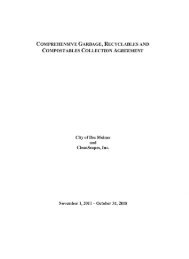CITY OF DES MOINES SHORELINE MASTER PROGRAM
CITY OF DES MOINES SHORELINE MASTER PROGRAM
CITY OF DES MOINES SHORELINE MASTER PROGRAM
Create successful ePaper yourself
Turn your PDF publications into a flip-book with our unique Google optimized e-Paper software.
Des Moines Shoreline Inventory and Characterization<br />
Segment E - Woodmont / Redondo North<br />
Table 13 below summarizes the shoreline characterization for Segment E.<br />
Table 13. Shoreline Segment “E” Summary<br />
Land Use /<br />
Transportation<br />
Stream<br />
Discharges<br />
Stream:<br />
Woodmont<br />
Creek<br />
Public Shoreline<br />
Access<br />
Hazard Areas<br />
Habitat / Habitat<br />
Potential<br />
Single-Family Res.:<br />
87%, Multi-Family:<br />
6%;<br />
Local streets<br />
None<br />
Landslide,<br />
Erosion<br />
Wetlands, Streams,<br />
Banks/Bluffs, Fish &<br />
Wildlife Areas<br />
(Forage Fish,<br />
Salmonids, seabird<br />
nesting, shorebirds<br />
and piscivorous birds,<br />
shellfish, eelgrass)<br />
Segment E provides few opportunities for restoration/enhancement of shoreline functions. Much<br />
of the shoreline in Segment E is privately owned with a majority being developed single-family<br />
residential areas and local streets. However, public education to promote the installation of<br />
native vegetation plantings versus manicured lawns along the shoreline portion of the private<br />
properties would be of value in restoring some shoreline function. Similarly, education or<br />
incentive for shoreline bulkhead removal in Segment E would help restore natural shoreline<br />
processes for significant lengths of the City shore in this formerly important reach of feeder bluff<br />
(CGS, in prep.)<br />
Several failed bulkheads are present approximately 2,000 feet south of the southern boundary of<br />
Saltwater Stare Park. These include a cluster of three wooden soldier pile walls in the intertidal<br />
beach (CGS, in prep.) that are no longer protecting the bluff from erosion. Simple pile removal<br />
would help restore natural beach conditions and bluff processes. Some of these may be<br />
creosoted piles, so additional water quality benefits could be reaped.<br />
The Woodmont Creek subestuary and delta have been severely impaired by shoreline armoring<br />
and shoreline development. Woodmont Creek is culverted beneath residential areas and<br />
roadways for a distance of approximately 500 feet from the mouth. This is likely a fish passage<br />
barrier to anadromous salmonids. Removal of the culverts and other barriers could be a good<br />
longer-term goal for restoration of the creek, but access to houses is a significant problem to<br />
overcome for this type of project.<br />
March 2005 Page 49



